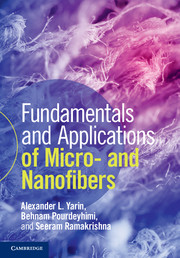Book contents
- Frontmatter
- Contents
- Preface
- 1 Introduction
- 2 Polymer physics and rheology
- 3 General quasi-one-dimensional equations of dynamics of free liquid jets, capillary and bending instability
- 4 Melt- and solution blowing
- 5 Electrospinning of micro- and nanofibers
- 6 Additional methods and materials used to form micro- and nanofibers
- 7 Tensile properties of micro- and nanofibers
- 8 Post-processing
- 9 Applications of micro- and nanofibers
- 10 Military applications of micro- and nanofibers
- 11 Applications of micro- and nanofibers, and micro- and nanoparticles: healthcare, nutrition, drug delivery and personal care
- Subject Index
- References
1 - Introduction
Published online by Cambridge University Press: 05 June 2014
- Frontmatter
- Contents
- Preface
- 1 Introduction
- 2 Polymer physics and rheology
- 3 General quasi-one-dimensional equations of dynamics of free liquid jets, capillary and bending instability
- 4 Melt- and solution blowing
- 5 Electrospinning of micro- and nanofibers
- 6 Additional methods and materials used to form micro- and nanofibers
- 7 Tensile properties of micro- and nanofibers
- 8 Post-processing
- 9 Applications of micro- and nanofibers
- 10 Military applications of micro- and nanofibers
- 11 Applications of micro- and nanofibers, and micro- and nanoparticles: healthcare, nutrition, drug delivery and personal care
- Subject Index
- References
Summary
The first chapter is devoted to the traditional methods of fiber forming, which are used to produce macroscopic fibers. Since the novel methods used to form micro- and nanofibers described in this monograph have branched from the traditional methods, an introduction into the history of manmade fibers is instructive and fully appropriate (Section 1.1). There is a brief discussion of such traditional extrusion methods of fiber forming as melt spinning (Section 1.2), dry spinning (Section 1.3), wet spinning (Section 1.4) and the integrated process of spunbonding, which is used to form nonwoven fiber webs (Section 1.5). Melt and dry spinning are closely related to the electrospinning used to produce nanofibers, so the discussion of these traditional methods allows a first glimpse of electrospinning, covered in Chapter 5. One of the key elements of spunbonding is pulling polymer filaments by fast co-flowing air, which is known as meltblowing. Meltblowing, and its offshoot solution blowing, are also used to form micro- and nanofibers, as detailed in Chapter 4. In a sense, Section 1.5 serves as an introduction to the nonwoven nanofiber mats discussed later. Section 1.2 also contains some elements of quasi-one-dimensional theory; namely, its application to the draw resonance instability of melt spinning. In its more involved form a similar quasi-one-dimensional approach is applied in Chapters 3–6 to describe processes characteristic of melt- and solution blowing and electrospinning used to form micro- and nanofibers.
History and outlook
The term fiber originates from the French word fibre, from Latin fibra “a fiber, filament,” of uncertain origin, perhaps related to Latin filum “thread,” or from the root findere “to split” (Online Etimology Dictionary 2013). For centuries, the use of fibers was limited to natural materials such as cotton and linen, which had inherent problems with wrinkling. Silk was difficult to produce and was often too delicate. Wool was strong and abundant, but would shrink and was irritating next to the skin, and would not last long, as it was a food source for moths.
Information
- Type
- Chapter
- Information
- Publisher: Cambridge University PressPrint publication year: 2014
